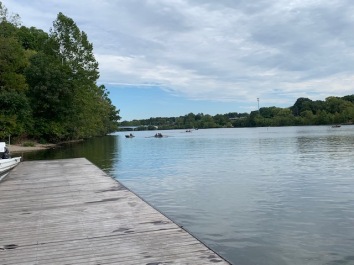Faster Masters is following one athlete’s progress towards the Head of the Charles 2019. Casey McKenna is a 35 year old single sculler, a mom fo a 2 year old. She trains alone since her job relocted to Kentucky and she was massivly excited when she got her entry into the HOCR this year – it’s her first time. We will be following her blog updates weekly through to the race, and beyond!

Ever since I resumed training for specific rowing events, I’ve written my training plan. That’s partially been out of necessity: no rowing team here, no outside coach to be the guide, no boat to motivate through the tough times. Mix that in with new limitations to my time (hello, toddler!) and resources (where’s the water?) and writing my own plan just made sense.
The thing is, writing my personal training plan has been time-consuming. Part of that might be how I structure the workouts. I’m always asking myself, “Am I doing the right thing? Is this the right workout at this time?” I like variety, so you don’t see much repetition in the erg sessions.
As I prep for my first Head of the Charles, I’m giving the Faster Masters program a go. I plan to give an update each week for the next six weeks.
Week 1- Diving into training
I once participated in both a sweep and sculling clinic from Marlene Royle, whose instruction I credit with helping me win my first 1x race. And I listen into Rebecca Caroe on the RowingChat/ Faster Masters podcast, so I was excited to jump into the resources they offer. The program is broken into modules, but when I launched last Monday morning I needed to dive in quick.
The training plan is the first module. The guidelines spell out how the training works whether you’re erging a lot, like me, or have the benefit of water training. There are four training plans available. I’m picking up September’s plan for an October/November 5k peak.

It’s simple to understand, but my Florida-native brain trips me up when reading workout intensity. “Category 1” usually means bring out the margaritas and board your windows while “Category 5” means “Run for the hills because it’s about to get real.” Here it’s reversed: Cat I workouts are the most intense while V and VI are more steady state.
Initial Thoughts
Flexibility is the key reason I’ve been writing my plans. The kid could be sprinting across the house one day and running a fever the next. Some weeks I can only do four workout sessions. Others I hammer out six sessions. I can’t break up my workouts, as in row/erg in the morning and strength train/erg in the afternoon. I get up to two hours to smush in as much quality as I can. Erg, then immediately strength. If I’m lucky, I might have time for yoga or stretching later in the day.
Case-in-point for last week: I only had five days of training instead of a typical six because of traveling for two days.
The training guidelines advise you on how to fit the recommended training into 4, 5 or 6 days. I like that certain workouts in the plan are designated “priority.” So I focused on hitting those sessions and dropped a 60-minute row. But Week 2, as long as everything chugs along like normal, I’ll hit all six sessions.
The program isn’t so rigid that I can’t move things around to accommodate my schedule. Example: when I logged in to the training plan on Monday, I actually had a “rest” day. I typically use Sunday as a rest day, so I simply moved Sunday’s workout to Monday.
And it flows between water sessions and erg sessions, which is great since I never know for sure when the 1x will get wet. I had a chance to row a Women’s 2x in Columbus last weekend. My partner was on board with doing the scheduled Saturday workout. We had a solid row, I exposed a technical weakness, and she liked the workout better than the one the Coach intended for the session. Triple win.

There is rowing in Columbus, Ohio!
Tracking progress
My past training plans look like a box of chocolates…you never know what you’re gonna get. When you’re staring at black numbers and a white wall for over an hour, some mental spice is necessary. I achieved that by frequently dishing out something new. I always made sure to hit two hard steady states, two anaerobic, etc, but I’d rarely do the same type of hard steady-state twice in the workouts. Some key sessions would occasionally repeat, like 3x 20m x 3mr at 18-20, but not with any real frequency.
This training plan is the same throughout the month. So Tuesday’s workout is Tuesday’s workout all four weeks.
I’m looking forward to seeing how this works for me. I think right now repeating each week will be super motivating because I’ve become very competitive against myself. I keep a rowing workout journal and track every session. I’ll know if I’m showing progress from Week 1 to Week 3 (Three and not four weeks, in this case, having picked it up the month a week late).
Resources
There’s a treasure trove of resources included in this plan! While I didn’t have time until my weekend car ride to start sifting through the materials, I look forward to exploring more. Already the erg video drill has been helpful, especially since that rolling seat and I are intimately acquainted.
How’d it go?
I think the first week went well. I learned after the first land training session I needed to up my weights quite a bit. After the second one weight session, which paired with a fairly intense erg session, I was a little sore the next day.

Working on those front squats.
This month includes hip mobility, which I was grateful to see. Given the struggles I’ve had figuring out why my low back/left hip has a clicking and pulling sensation, it was timely. Working on my hip flexibility through stretching and sitting less has been a priority the last few weeks. I’ve jumped on adding this routine in my week. The first time I did it, my hip “popped” during one stretch, but in a good way.
I’m looking forward to seeing how Week 1 stacks up against Week 2.


